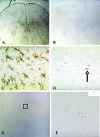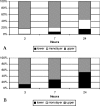Interaction of a neurotropic strain of Borrelia turicatae with the cerebral microcirculation system
- PMID: 16940140
- PMCID: PMC1695479
- DOI: 10.1128/IAI.00538-06
Interaction of a neurotropic strain of Borrelia turicatae with the cerebral microcirculation system
Abstract
Relapsing fever (RF) is a spirochetal infection characterized by relapses of a febrile illness and spirochetemia due to the sequential appearance and disappearance of isogenic serotypes in the blood. The only difference between isogenic serotypes is the variable major outer membrane lipoprotein. In the absence of specific antibody, established serotypes cause persistent infection. Studies in our laboratory indicate that another consequence of serotype switching in RF is a change in neuroinvasiveness. As the next step to elucidate this phenomenon, we studied the interaction of the neurotropic Oz1 strain of the RF agent Borrelia turicatae with the cerebral microcirculation. During persistent infection of antibody-deficient mice, we found that serotype 1 entered the brain in larger numbers and caused more severe cerebral microgliosis than isogenic serotype 2. Microscopic examination revealed binding of B. turicatae to brain microvascular endothelial cells in vivo. In vitro we found that B. turicatae associated with brain microvascular endothelial cells (BMEC) significantly more than with fibroblasts or arachnoidal cells. The binding was completely eliminated by pretreatment of BMEC with proteinase K. Using transwell chambers with BMEC barriers, we found that serotype 1 crossed into the lower compartment significantly better than serotype 2. Heat killing significantly reduced BMEC crossing but not binding. We concluded that the interaction of B. turicatae with the cerebral microcirculation involves both binding and crossing brain microvascular endothelial cells, with significant differences among isogenic serotypes.
Figures







Similar articles
-
Coinfection with Borrelia turicatae serotype 2 prevents the severe vestibular dysfunction and earlier mortality caused by serotype 1.J Infect Dis. 2007 Jun 1;195(11):1686-93. doi: 10.1086/516783. Epub 2007 Apr 17. J Infect Dis. 2007. PMID: 17471439
-
Residual brain infection in relapsing-fever borreliosis.J Infect Dis. 2006 May 15;193(10):1451-8. doi: 10.1086/503367. Epub 2006 Apr 4. J Infect Dis. 2006. PMID: 16619194
-
High production of CXCL13 in blood and brain during persistent infection with the relapsing fever spirochete Borrelia turicatae.J Neuropathol Exp Neurol. 2007 Mar;66(3):208-17. doi: 10.1097/01.jnen.0000248556.30209.6d. J Neuropathol Exp Neurol. 2007. PMID: 17356382
-
The mammalian host response to borrelia infection.Wien Klin Wochenschr. 2006 Nov;118(21-22):653-8. doi: 10.1007/s00508-006-0692-0. Wien Klin Wochenschr. 2006. PMID: 17160603 Review.
-
Neuroborreliosis during relapsing fever: review of the clinical manifestations, pathology, and treatment of infections in humans and experimental animals.Clin Infect Dis. 1998 Jan;26(1):151-64. doi: 10.1086/516276. Clin Infect Dis. 1998. PMID: 9455525 Review.
Cited by
-
Mechanisms of microbial traversal of the blood-brain barrier.Nat Rev Microbiol. 2008 Aug;6(8):625-34. doi: 10.1038/nrmicro1952. Epub 2008 Jul 7. Nat Rev Microbiol. 2008. PMID: 18604221 Free PMC article. Review.
-
Understanding tropism and immunopathological mechanisms of relapsing fever spirochaetes.Clin Microbiol Infect. 2009 May;15(5):415-21. doi: 10.1111/j.1469-0691.2009.02785.x. Clin Microbiol Infect. 2009. PMID: 19489924 Free PMC article. Review.
-
Interleukin 10 protects the brain microcirculation from spirochetal injury.J Neuropathol Exp Neurol. 2008 Oct;67(10):976-83. doi: 10.1097/NEN.0b013e318187a279. J Neuropathol Exp Neurol. 2008. PMID: 18800010 Free PMC article.
-
Structure-function investigation of vsp serotypes of the spirochete Borrelia hermsii.PLoS One. 2009 Oct 30;4(10):e7597. doi: 10.1371/journal.pone.0007597. PLoS One. 2009. PMID: 19888463 Free PMC article.
-
Is Borrelia burgdorferi Sensu Stricto in South America? First Molecular Evidence of Its Presence in Colombia.Trop Med Infect Dis. 2022 Dec 11;7(12):428. doi: 10.3390/tropicalmed7120428. Trop Med Infect Dis. 2022. PMID: 36548683 Free PMC article.
References
-
- Alugupalli, K. R., R. M. Gerstein, J. Chen, E. Szomolanyi-Tsuda, R. T. Woodland, and J. M. Leong. 2003. The resolution of relapsing fever borreliosis requires IgM and is concurrent with expansion of B1b lymphocytes. J. Immunol. 170:3819-3827. - PubMed
-
- Bai, Y., K. Narayan, D. Dail, M. Sondey, E. Hodzic, S. W. Barthold, A. R. Pachner, and D. Cadavid. 2004. Spinal cord involvement in the nonhuman primate model of Lyme disease. Lab. Investig. 84:160-172. - PubMed
Publication types
MeSH terms
LinkOut - more resources
Full Text Sources
Research Materials

